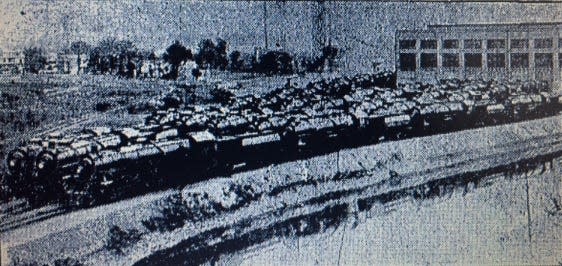The Monday After: 'Special' stops in Stark County

The "Prosperity Special" – a record 20 locomotives on a train – journeyed through Canton 100 years ago and made quite a spectacle of itself.
"HUGE ENGINES ARE INSPECTED BY CANTONIANS," reported The Evening Repository on the front page Wednesday, May 31, 1922.
"Crowds Jam Pennsy Station To Greet 'Prosperity Special,'" a second headline said.
A throng gathered to greet a great wonder on rails.
"Streets leading to the Pennsylvania railroad station were jammed for blocks Tuesday evening when Canton turned out to welcome the 'Prosperity Special,' a train of 20 oil burning locomotives to be used in the west by the Southern Pacific Lines.
"G.W. Irwin, local agent, said it was the largest crowd that had visited the station since the war."
World War I was long over by the spring of 1922. The news the "Prosperity Special" was making a century ago was of a peaceful kind. And, indeed it was a prosperous business transaction that was being brought to life by the train's journey west.
The Repository reported the "Prosperity Special" was valued about $1.5 million. That's the equivilant of between $34 million and $35 million in today's dollars.
The train of 20 oil engines – stretching nearly a half-mile and weighing 6,000 tons – was drawn much of the way by three coal burning locomotives, and it was part of an order of 50 freight locomotives heading west.
The train arrived about 6 p.m. May 30, 1922, and was parked on the north and south tracks at the Pennsylvania Railroad Station on Market Avenue South in Canton. The train was separated into two sections, and was placed on each side of the island platform at the station, where it stayed overnight for about 12 hours.
Before it arrived in Canton, the train, with its locomotives built by the Baldwin Locomotive works at Philadelphia, had made layovers in Altoona and Pittsburgh.
Other stops for the train during its trip included Perrysville, Maryland; Fort Wayne and Terre Haute, Indiana; and St. Louis.
The last stop before Canton was a smaller city and a shorter stay, but a significant one.
"The train is scheduled to reach Alliance Tuesday afternoon at 4 o'clock," noted an article published in the Repository before the train arrived in Ohio. "Numerous parts on the engines were made at the plant of the American Steel Foundry company in Alliance."
Statistics about train drew onlookers
No doubt the newspapers description of the train help draw a crowd to the Pennsy station later that day.
"The engines are 3,000 horsepower each and they cost approximately $75,000 each," the newspaper said. "Each engine (with its tender) is nearly 100 feet long."
Each locomotive in the train carried one man during the trip, the newspaper noted, "who is responsible for his engine throughout the entire trip." At some points of steep grade, such as the Horseshoe Curve in the Allegheny Mountains in Pennsylvania, six engines – pullers and pushers – were needed to power the train.
"On account of some bridges not being able to bear the tremendous weight and to avoid narrow tunnels and clearances in certain sections, many detours were found necessary in planning its movement to the west," said an article published in the Repository on May 26, 1922, promoting the train's journey.
According to articles in the Repository, the train was bound for Los Angeles. With its departure watched by many Pennsylvania dignitaries, the locomotives had begun their journey on May 22, 1922, and arrived in California in June. According to one online history of the event, the train of locomotives was "the most valuable ever moved in the United States as a single unit until then."
"It was only possible to haul 20 of these heavy locomotives in a single train, and it required several pulling and pushing locomotives on level stretches, while in passing over the Allegheny Mountains west of Altoona, additional helping power was needed," noted the online history, citing information from a 1922 article entitled "A notable shipment of locomotives" in a publication called "The Locomotive."
Train viewed while in Canton
According to the online history, "no attempt at speed was made at any point, and this also permitted the train to be reviewed by millions of people throughout its long journey."
"At many of the stopping places and in a large number of cities through which it passed, state and municipal authorities, officers and members of chambers of commerce, boards of trade, commercial and industrial organizations, public school authorities and local trade and business associations made arrangements to review the train as it passed through their localities. At the night stopping places, opportunity was afforded for a close inspection of the locomotives."
The article in the Repository on May 31, 1922, reported that "Crowds Jam the Pennsy Station To Greet 'Prosperity Special.'"
"During the stay in Canton, representatives of the Canton Chamber of Commerce inspected the engines," the article said.
Samuel M. Vauelain, president of the Baldwin works, explained the moniker of the train, which "has been made possible by the courage of the Southern Pacific and Pennsylvania railroads."
"It marks the return of prosperity to the nation, for prosperity returns to the railroads after everything else," he said.
"It also demonstrates the safety and efficiency of the podern transportation system," he noted, "and it will demonstrate that the present railroad bridges of this country are the safest in the world."
Reach Gary at gary.brown.rep@gmail.com. On Twitter: @gbrownREP.
This article originally appeared on The Repository: The Monday After: 'Special' stops in Stark County
